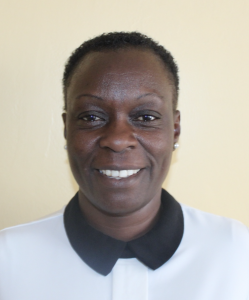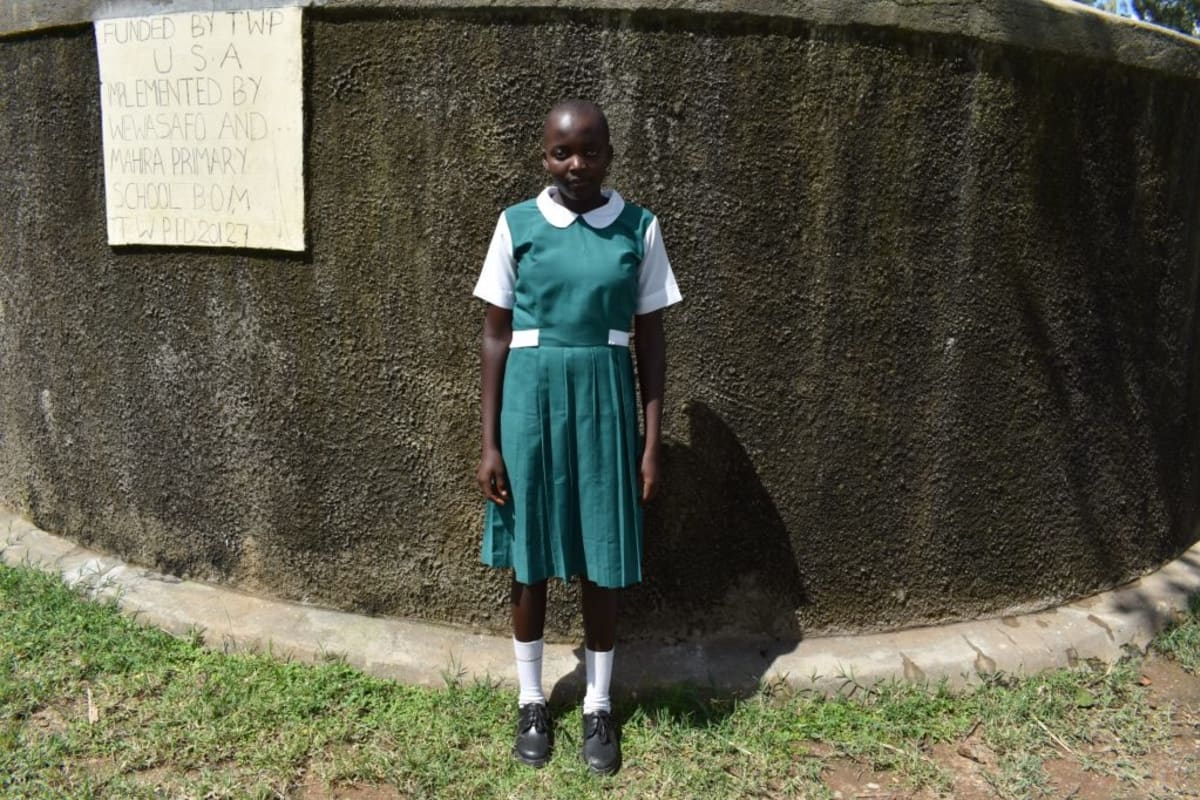April, 2020: Friends School Mahira Primary Project Complete!
Please note, all photos in this report were taken before social distancing recommendations went into effect.
Friends School Mahira Primary in Kenya now has access to a new source of safe, clean water thanks to the completion of their rain tank, which has the ability to collect 75,000 liters of water! We installed new latrines and handwashing stations for students, and we trained students and staff on improved sanitation and hygiene practices. All of these components work together to unlock the opportunity for these students to live better, healthier lives.

A pupil fetches water from the new rain tank
"Initially, I used to carry water from home, but now I have reliable, safe, and clean water. Academically, I will improve because I was wasting my time meant for learning to go and look for water," said young teenage student Brilliant.
When asked what some of her hopes and goals were both personally and for her school following the implementation of this project, Brilliant said, "Cleanliness of toilets will be done daily. After visiting the toilet I will wash my hands and I will improve academically. Generally, hygiene and sanitation standards will improve."

Students and teachers pose with the rain tank
Teachers and adults were just as excited as the students about the new rain tank on campus.
"I want to thank God through your team who remembered us this year. I am happy for the water tank, which will help to access safe and reliable water. Pupils will not waste time looking for water. The pupils will now have sufficient time to concentrate on their academic work. God willing I expect their performance in academics to improve," said Board of Management Chair Silvester Abuyeka.

Board of Management Chair Silvester Abuyeka
"In addition, access to sufficient water will enable the general cleanliness and hygienic standards at the school to improve. There is going to be enough water for handwashing, cleaning of toilets, and to supply to water to the handwashing facilities."
"I know the population of the school will increase [because of these facilities]. There will be an improvement in performance academically, and access to sufficient water will be enhanced."
Rain Tank
Construction for this 75,000-liter rain tank was successful!
Before schools closed in Kenya due to the COVID-19 pandemic, parents, staff, and students helped our artisans gather everything needed for construction. All the while, the school cooks and community members prepared meals for the artisans, and the school provided accommodations for the artisans during their work. Local women and men helped our artisans with their manual labor, too.

Students bring water for construction
The process officially began with our staff and school administration looking around the school compound to try and determine the best location for a new rain tank. This needed to be the best site with enough land and a nearby building with good, clean roofing to catch the rainwater.

Rain tank foundation work
Then, we cleared the site by excavating the soil to make level ground for the tank foundation. The foundation was cast by laying big stones on the level ground and reinforcing them using steel wire, concrete, and waterproof cement. Both the drawing pipe as well as the drainage pipe were affixed as the foundation was laid.

Community members held the artisan mix and pour the concrete for the rain tank's foundation
Next, the walls were formed using a skeleton of rebar and wire mesh with sugar sacks temporarily tied to the outside as backing. This was attached to the foundation’s edges so that the work team could start the Ferro-cementing process, in which the walls are layered with cement alternating with the inner and outer side until 6 layers of cement are in place. (The sugar sacks are removed once the interior receives its first 2 layers of cement.)

Students look on as a team fits the wire tank form over the foundation
Inside the tank, 1 central and 4 support pillars were cast to ensure the dome does not cave in once cemented. Meanwhile, the inner wall was plastered while the outer walls received their roughcasting. Outside of the tank, the access area to the tap was dug, plastered, and a short staircase installed, along with a soak pit where spilled water can drain from the access area through the ground. This helps to keep the tap area dry and tidy.

Interior cement, plaster, and pillar work underway
Dome construction could begin after the tank walls had been given enough time to settle. Using similar techniques as used on the walls, the dome started as rebar, wire mesh, and sugar sacks and was attached to the tank walls before receiving cement and plaster. A small manhole cover was built into the dome to allow access for future cleanings and water treatments.

Knitting the plastic sacks to the dome's wire form
Long wooden poles (about 75 of them!) were placed inside the tank to support the dome while it cured. A lockable manhole cover was fitted over the tap area, the gutters were affixed to the roof and the tank, and an overflow pipe was set in place at the edge of the dome for when the tank reaches capacity.

Dome and access area work
Once finished, the rain tank was given 3-4 weeks to undergo complete curing. Finally, the interior support poles and dome sugar sacks were removed, the tank was cleaned, and we waited as rain filled the tank with fresh water. When there was a sufficient volume in the tank, we treated the water and we officially handed it over to Friends School Mahira Primary.

Working on dome cement
As soon as it was ready, students and staff celebrated the presence of clean water on campus. The event was a great chance for us to acknowledge the school administration and students as the primary parties entrusted with the tools we have given, as well as remind them of our continued support as they develop. Happiness, thanksgiving, and appreciation were the order of the day flowing in all directions.

A student takes a fresh drink from the rain tank
VIP Latrines
This project funded the installation of 6 new ventilated improved pit (VIP) latrines, half for girls and half for boys.

Girls and a teacher stand in front of the new latrines
All of these new latrines have cement floors that are designed to be easy to use and clean, locking doors for safety and privacy, and vents designed to keep air flowing up and out through the roof. With a rain tank right on school property, there should be enough water to keep them clean.

Boys pose with the new latrines
Handwashing Stations
The 2 handwashing stations were set up during training and handed over to the student health club. These were placed outside of the girls’ and boys’ latrines to encourage handwashing after latrine use.

Handwashing with a new station
Health club members will teach other students how to properly wash their hands at the stations, make sure the stations are filled with water, and work to ensure that there is always a cleaning agent such as soap or ash available.

Handwashing with a new station
New Knowledge
Hygiene and sanitation training was scheduled with the help of the school principal, who ensured that the training date would be convenient for students, staff, and parent representatives. Individual teachers helped by selecting students from each class to represent the others. When the training day arrived, facilitators Betty Majani and Mary Afandi deployed to the site.
20 students attended training, which was held under the trees within the school compound. The location was very good for training. In addition to the students, the school's Board of Management Chair, Parent-Teacher Association Chair, and the Headmaster attended the training.

Lots of active participation from the students during a session with Trainer Mary
We covered a number of topics including personal hygiene such as bathing, oral hygiene, and the 10 steps of handwashing; environmental hygiene; child rights; operation and maintenance of the rain tank, latrines, and handwashing stations; and leadership and governance. During the latter, the students elected their peers to lead their newly formed student health club.

Trainer Betty holds out a tray of ash for a student to try handwashing with this locally available soap alternative
The club will be greatly involved in the water, sanitation, and hygiene project management at school and will be responsible for encouraging good health and hygiene practices amongst their peers, teachers, and the larger community. We involved stretches, dances, and physical activities in between each topic to keep the pupils’ energy up and their minds active. By the end of the training, each pupil understood their role in sustaining clean water and good health within their school community.

Students try out the new handwashing station
"Today I have learned unique topics which will help me in my future life and my people in school and at home. The most interesting topic was teenage and early pregnancy. I have learned as a boy to be focused and prioritize my life by not causing girls to suffer by causing them to drop out of school. Thanks for the knowledge you brought for us today," said young teenager Gideon.

When an issue arises concerning the water project, the students and teachers are equipped with the necessary skills to rectify the problem and ensure the water point works appropriately. However, if the issue is beyond their capabilities, they can contact our team of field officers to assist them. In addition, we will continue to offer them unmatchable support as a part of our ongoing monitoring and maintenance program.
Thank you for making all of this possible!


 Rainwater Catchment
Rainwater Catchment
 Rehabilitation Project
Rehabilitation Project













































